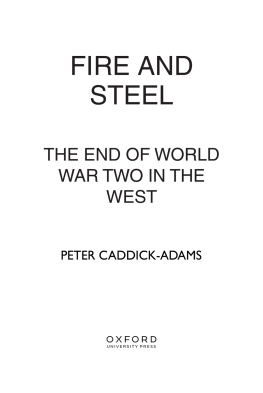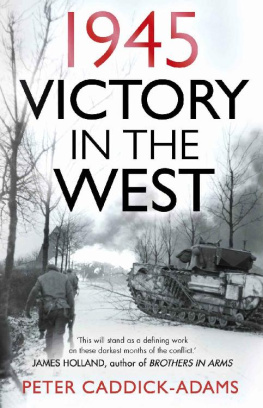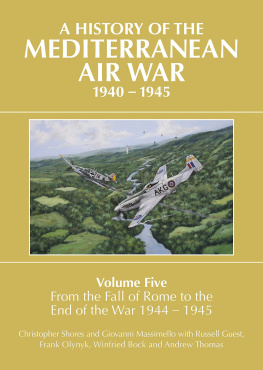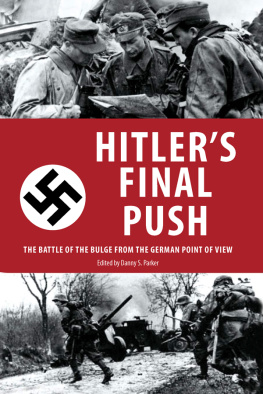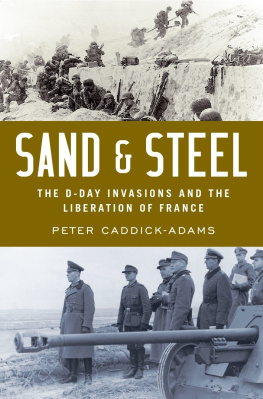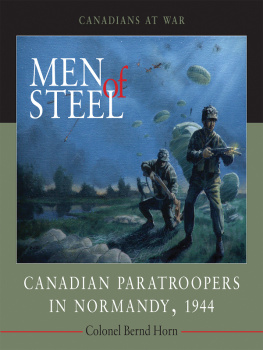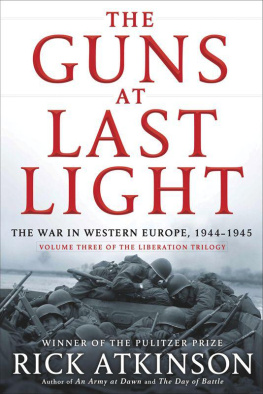FIRE AND
STEEL
ALSO BY PETER CADDICK-ADAMS
By God They Can Fight!: A New History of the 143rd Infantry Brigade
The Fight for Iraq: JanuaryJune 2003
Monty and Rommel: Parallel Lives
Monte Cassino: Ten Armies in Hell
Snow and Steel: The Battle of the Bulge 19445
Sand and Steel: The D-Day Invasion and the Liberation of France
FIRE AND
STEEL
THE END OF WORLD
WAR TWO IN THE
WEST



Oxford University Press is a department of the University of Oxford. It furthers
the Universitys objective of excellence in research, scholarship, and education
by publishing worldwide. Oxford is a registered trade mark of Oxford University
Press in the UK and in certain other countries.
Published in the United States of America by Oxford University Press 198 Madison Avenue, New York, NY 10016, United States of America.
Peter Caddick-Adams 2022
All rights reserved. No part of this publication may be reproduced, stored in
a retrieval system, or transmitted, in any form or by any means, without the
prior permission in writing of Oxford University Press, or as expressly permitted
by law, by license, or under terms agreed with the appropriate reproduction
rights organization. Inquiries concerning reproduction outside the scope of the
above should be sent to the Rights Department, Oxford University Press, at the
address above.
You must not circulate this work in any other form
and you must impose this same condition on any acquirer.
Library of Congress Control Number: 2022936918
eISBN 9780190601881
1 3 5 7 9 8 6 4 2
To A.L. LeQuesne
who taught me history
at Shrewsbury School (19741978)
&
Paul Beaver and Cate Pye
who have kindly accommodated, wined and dined
the wandering historian
during his many travels
Contents
Military folk worldwide, like many other communities, tend to adopt their own abbreviations, which they forget puzzle those outside. Military algebra, by which I mean the designation of divisions, brigades, regiments, battalions and so on, is particularly vexing to the uninitiated, hence this briefest of tool kits for your enlightenment.
Units of all the nations covered here followed much the same approach, in that their basic formation was the division. By 1945 German divisions had often shrunk to perhaps 10,000 and sometimes much less. Allied ones tended to vary between 12,000 and 15,000 men, depending on purpose (airborne, armoured or infantry). Divisions (usually commanded by a Major General, Generalmajor or Generalleutnant) were self-supporting, with their own reconnaissance, artillery, anti-aircraft and anti-tank, engineers, signals, machine-gun, supply, transport, ordnance (for repair), workshop (for vehicles), medical and military police elements.
All divisions were numbered, and often had a secondary title, which indicated where they recruited, for example 15th Scottish, 43rd Wessex and 53rd Welsh under Montgomery; or the 36th Texas and 42nd Rainbow (the latter drawing recruits from across the United States). Two divisions or more often many more made an army corps. Allied corps possessed their own heavy artillery (an AGRA, Army Group Royal Artillery in the Anglo-Canadian forces), anti-aircraft, armoured and reconnaissance units, a Mechanized Cavalry Group (in US corps), plus other assets.
Allied infantry divisions were broken down into three infantry brigades (regiments in US terminology), each of around 3,000 personnel, commanded by a Colonel or Brigadier (Brigadier General, or Gnral de Brigade). The Cottonbalers was the unofficial title of a US Army regiment, more formally titled the 7th Infantry. A brigade, in turn, comprised three battalions, led by lieutenant colonels, which remain the basic building blocks of military formations. Tank battalions (sometimes called armoured regiments) fielded around sixty tanks, infantry battalions contained 6001,000 riflemen, whilst artillery battalions (or regiments) comprised anything from nine to forty-eight guns, depending on type and calibre. Each generally included three infantry companies, armoured squadrons or artillery batteries, plus headquarters elements.
American and British airborne forces, with minimal transport, who deployed into battle by glider and parachute, fielded fewer numbers, as did British Commandos. The latter, all numbered, were split between the Navy (Royal Marine Commandos) and Army, each unit being the equivalent of a highly-trained, well-armed, but small battalion. Their US equivalents are Ranger battalions.
American battalions and regiments were numbered, while the Anglo-Canadians retained a variety of exotic and confusing titles for their battalions, evoking nineteenth-century antecedents. These included the 13th/18th Hussars, 22nd Dragoons and Staffordshire Yeomanry (all British tank battalions); 3rd Scots Guards (also a tank battalion); 13th Royal Horse Artillery (an artillery battalion); the Algonquin Regiment and the Cameron Highlanders of Ottawa (both Canadian infantry battalions, the latter fielding machine-guns); and 4th/5th Royal Scots Fusiliers, 5th Duke of Cornwalls Light Infantry and (bizarrely) the 12th Kings Royal Rifle Corps (all British battalions).
Now, for some TLAs (Three Letter Abbreviations) and others, which have crept past the censors and into this volume.
| 30 Assault Unit | British commando unit, raised by Ian Fleming, tasked to capture German codes, technical documents, equipment and personnel |
| AEF | American Expeditionary Force, which fought in World War One |
| AFS | American Field Service; an all-volunteer US force of ambulance drivers |
| AGRA | Army Group Royal Artillery; corps-level medium and heavy artillery units |
| AGRE | Army Group Royal Engineers; fielded troops for corps and army activities |
| AVRE | Armoured Vehicle Royal Engineers, based on the 40-ton Churchill tank |
| Army Group B | FM Models central German force; 5th Panzer, 7th and 15th Armies |
| Army Group G | SS Gen. Haussers force defending southern Germany; 1st and 19th Armies |
| Army Group H | Defended Holland with 1st Parachute and 25th Armies under Blaskowitz |
| BAR | Browning Automatic Rifle; US Army squad light machinegun, 20-round magazine, 0.30-06-inch calibre |
| Bagration | Soviet operation, 23 June 1944, to compliment D-Day in Normandy |
| BLA | British Liberation Army |
| Blackcock | British XII Corps operation to clear Roermond Triangle, 1327 January 1945 |
| Blockbuster | Canadian operation to clear Rhineland, 26 February to 3 March 1945 |
| Blue and White Devils | Nickname for 3rd US Infantry Division (Maj. Gen. John W. ODaniel) |
| Bren Carrier | British-Canadian 3-ton armed and armoured, tracked carrier for moving combat supplies and towing equipment |
| Bren gun | British-Czech .303-inch calibre, 30-round, magazine-fed, light machine-gun |

